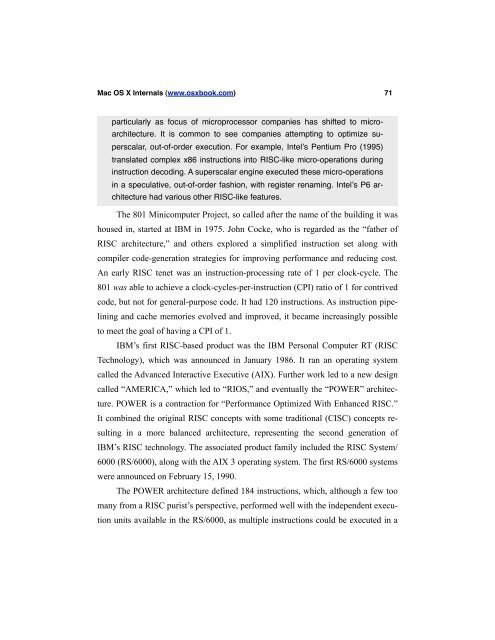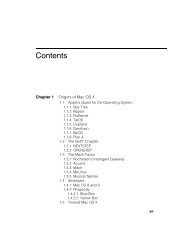A Technical History of Apple's Operating Systems - Mac OS X Internals
A Technical History of Apple's Operating Systems - Mac OS X Internals
A Technical History of Apple's Operating Systems - Mac OS X Internals
Create successful ePaper yourself
Turn your PDF publications into a flip-book with our unique Google optimized e-Paper software.
<strong>Mac</strong> <strong>OS</strong> X <strong>Internals</strong> (www.osxbook.com) 71<br />
particularly as focus <strong>of</strong> microprocessor companies has shifted to micro-<br />
architecture. It is common to see companies attempting to optimize su-<br />
perscalar, out-<strong>of</strong>-order execution. For example, Intel’s Pentium Pro (1995)<br />
translated complex x86 instructions into RISC-like micro-operations during<br />
instruction decoding. A superscalar engine executed these micro-operations<br />
in a speculative, out-<strong>of</strong>-order fashion, with register renaming. Intel’s P6 ar-<br />
chitecture had various other RISC-like features.<br />
The 801 Minicomputer Project, so called after the name <strong>of</strong> the building it was<br />
housed in, started at IBM in 1975. John Cocke, who is regarded as the “father <strong>of</strong><br />
RISC architecture,” and others explored a simplified instruction set along with<br />
compiler code-generation strategies for improving performance and reducing cost.<br />
An early RISC tenet was an instruction-processing rate <strong>of</strong> 1 per clock-cycle. The<br />
801 was able to achieve a clock-cycles-per-instruction (CPI) ratio <strong>of</strong> 1 for contrived<br />
code, but not for general-purpose code. It had 120 instructions. As instruction pipe-<br />
lining and cache memories evolved and improved, it became increasingly possible<br />
to meet the goal <strong>of</strong> having a CPI <strong>of</strong> 1.<br />
IBM’s first RISC-based product was the IBM Personal Computer RT (RISC<br />
Technology), which was announced in January 1986. It ran an operating system<br />
called the Advanced Interactive Executive (AIX). Further work led to a new design<br />
called “AMERICA,” which led to “RI<strong>OS</strong>,” and eventually the “POWER” architec-<br />
ture. POWER is a contraction for “Performance Optimized With Enhanced RISC.”<br />
It combined the original RISC concepts with some traditional (CISC) concepts re-<br />
sulting in a more balanced architecture, representing the second generation <strong>of</strong><br />
IBM’s RISC technology. The associated product family included the RISC System/<br />
6000 (RS/6000), along with the AIX 3 operating system. The first RS/6000 systems<br />
were announced on February 15, 1990.<br />
The POWER architecture defined 184 instructions, which, although a few too<br />
many from a RISC purist’s perspective, performed well with the independent execu-<br />
tion units available in the RS/6000, as multiple instructions could be executed in a




